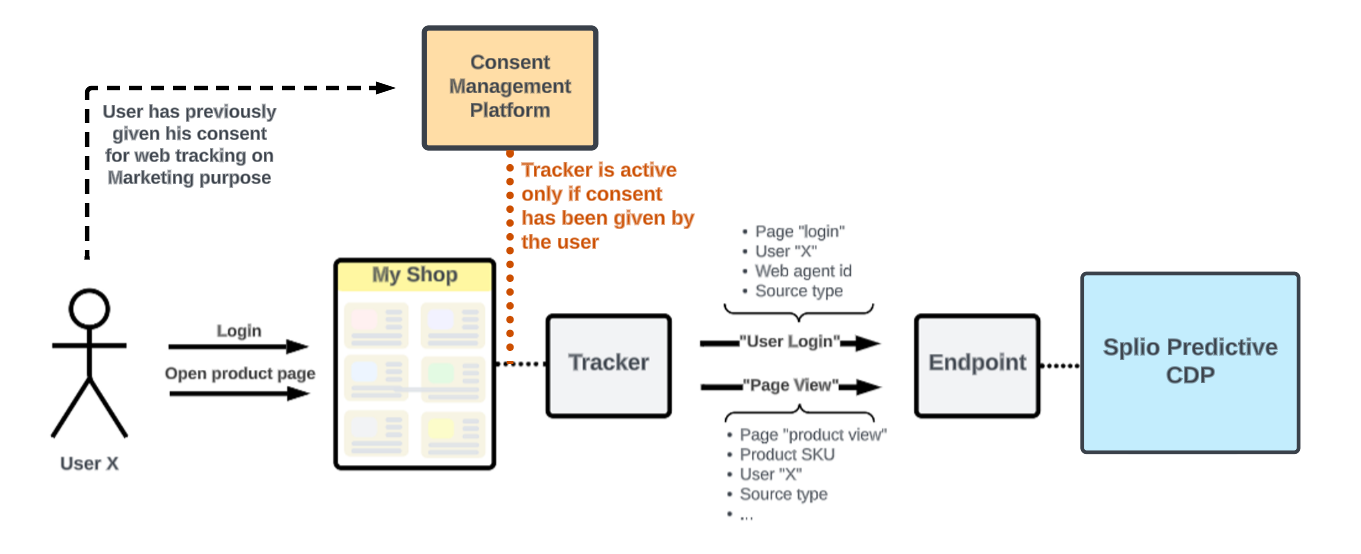Web tracking
The Splio Predictive CDP can be alimented with various sources, one of them being the web tracking events directly pushed from your websites. With these events, the Splio CDP cutting-edge predictive engine can gather more feedback on your customer experiences, and help you improve your marketing strategy.
Provided by: Splio Connector type: source Third-party system: E-commerce Available for Splio • License: Only for "Marketing Automation + CDP" • Add-ons: Loyalty, Mobile Wallets, Predictive AI, Identity Resolution
Early access featurePlease note that this is accessible only through an early access program. As such, it may be subject to changes, including additions, modifications, or removals, as we continue to refine and optimize the product. If you are interested to join the early access program, please reach out to [email protected] or to your Splio contact and feel free to share any feedback.
Marketing use cases
Splio web tracking can help you to leverage your navigation data for three main marketing use cases:
- Boost email personnalization capabilities
- Define a product recommendation for your customers, build by the Splio CDP Predictive engine based on preferred product analysis
- Last 3 product viewed in a dedicated banner of your newsletter and transactional email
- With Predictive AI add-on: boost predictive algorithm
- Abandoned Cart Recovery
- Detect users who added products to their cart but did not complete a purchase.
- Reconstruct realistic cart content using Add To Cart and Remove From cart events.
- Trigger personalized re-engagement campaigns (email reminders, push notifications) to recover lost sales and increase conversion rates.
Prerequisites for access to Splio CDP Web Tracking feature
- Your e-commerce is equipped with a CMP (Consent Management Platform) and Google Tag Manager (recommended).
- The Splio CDP Web tracking must have been configured for your account during the integration project.
- Product and user identifiers must be known both by your web tracking source site and the Splio CDP and if your contact key is the email, you should be able to provide the email hashed in SHA256 through the data layer.
Web tracking integration in Splio Predictive CDP
To do so, a dedicated endpoint is available, and can ingest various type of events published with a standard web tracker.
Data identified from these events is then processed in the Splio Predictive CDP data model as any other source :

In this section you will find a definition of the event types which can be ingested by Splio CDP, and a guide for their integration in your website.
Web tracking is a technique which consists of identifying visitor activities to a website, using various identifiers (cookie, IP address, user-agent tagging, signed-up user id …), then reconstructing their journey, for the purposes of marketing analysis.
Overview of the web tracking technology supported by Splio CDP
Three different components are required to gather web tracking :
- One Consent Manager Platform (CMP), active in the web site. It collect and manage consents given by end users
- One tracker, integrated in the web site. It is active only if the end-user has provided first his free, specific, informed and unequivocal consent. It can be :
- “Frontend-side” : a library for a frontend technology (js/ts, react/angular/vue.js …), an html tag syntax, or a tag template managed through a tag manager solution (like GTM - Google Tag Manager). Events are directly sent by the user navigator to the tracking endpoint
- “Server-side” : a library for a backend technology (python, java, nodejs, php, go …). Events are sent directly from the server to the tracking endpoint
- One server, which collect the requests (”web tracking events”) from the tracker, record and analyze them for journey building

CMP / Tracker / Endpoint in web tracking event gathering
The Splio CDP platform includes a dedicated public server for collecting the web tracking events, which currently supports the Snowplow opensource web tracker and will be open to more formats later.
To integrate web tracking in Splio Predictive CDP, you basically just have to integrate one of the supported standard tracker (frontend or backend) in your standard tag manager, and configure it to :
- Use one or more of the supported event types
- Request the Splio Web Tracker endpoint.
As with any web tracking solution, your website must conform to GDPR. Tracked events must be sent only for granted consent from the users. It is recommended to integrate a Tag Manager and a Consent Manager Platform to gather your end users' consents, and to enable tracker only when it is possible.
For more details on our recommendation on consent management and on tracker cookie policy, you can check this dedicated chapter (link to cookie management).
The event types supported by Splio CDP Web tracking integration
At this moment, the supported event types are :
- Page View, Product View or Thank You Page View, which can include these optional contextual information :
- A product identification (Allowing for “product view” identification by the Splio Predictive engine)
- A logged in user identifier (Allowing for reconciliation of anonymous and authenticated traffic)
- A flag that indicates if an order has been completed (Thank you page visited)
- Add To Cart which can include this optional contextual information :
- A logged in user identifier (Allowing for reconciliation of anonymous and authenticated purchase, and detection of abandoned cart)
- Remove From Cart which can include the optional contextual information:
- A logged in user identifier (Allowing for reconciliation of anonymous and authenticated purchase, and detection of abandoned cart)
Note: Anonymous navigation reconciliation is done over the last 30 days by default. This time window is configurable within the CDP settings.
These events work together to enable advanced marketing automation features like abandoned cart detection. The CDP analyzes the sequence of Add To Cart, Remove From Cart, and Thank You Page View events to identify abandoned carts and trigger appropriate marketing campaigns.
Updated 2 months ago
